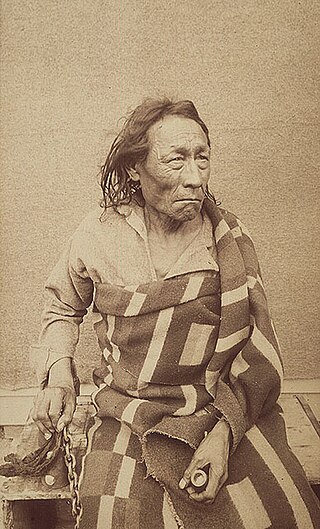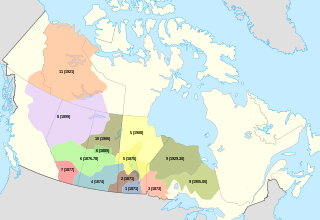Related Research Articles

Buffy Sainte-Marie, is an American singer-songwriter, musician, and social activist.
Indigenous music of Canada encompasses a wide variety of musical genres created by Aboriginal Canadians. Before European settlers came to what is now Canada, the region was occupied by many First Nations, including the West Coast Salish and Haida, the centrally located Iroquois, Blackfoot and Huron, the Dene to the North, and the Innu and Mi'kmaq in the East and the Cree in the North. Each of the indigenous communities had their own unique musical traditions. Chanting – singing is widely popular and most use a variety of musical instruments.

Big Bear, also known as Mistahi-maskwa, was a powerful and popular Cree chief who played many pivotal roles in Canadian history. He was appointed to chief of his band at the age of 40 upon the death of his father, Black Powder, under his father's harmonious and inclusive rule which directly impacted his own leadership. Big Bear is most notable for his involvement in Treaty 6 and the 1885 North-West Rebellion; he was one of the few chief leaders who objected to the signing of the treaty with the Canadian government. He felt that signing the treaty would ultimately have devastating effects on his nation as well as other Indigenous nations. This included losing the free nomadic lifestyle that his nation and others were accustomed to. Big Bear also took part in one of the last major battles between the Cree and the Blackfoot nations. He was one of the leaders to lead his people in the last, largest battle on the Canadian Plains.
Treaty Five is a treaty between Queen Victoria and Saulteaux and Swampy Cree non-treaty band governments and peoples around Lake Winnipeg in the District of Keewatin. Much of what is today central and northern Manitoba was covered by the treaty, as were a few small adjoining portions of the present-day provinces of Saskatchewan and Ontario.

Treaty 6 is the sixth of the numbered treaties that were signed by the Canadian Crown and various First Nations between 1871 and 1877. It is one of a total of 11 numbered treaties signed between the Canadian Crown and First Nations. Specifically, Treaty 6 is an agreement between the Crown and the Plains and Woods Cree, Assiniboine, and other band governments at Fort Carlton and Fort Pitt. Key figures, representing the Crown, involved in the negotiations were Alexander Morris, Lieutenant Governor of Manitoba and The North-West Territories; James McKay, The Minister of Agriculture for Manitoba; and William J. Christie, a chief factor of the Hudson's Bay Company. Chief Mistawasis and Chief Ahtahkakoop represented the Carlton Cree.
First Nations in Manitoba constitute of over 160,000 registered persons as of 2021, about 57% of whom live on reserve. Manitoba is second to Ontario in total on-reserve population and in total First Nation population.

The Anisininew or Oji-Cree are a First Nation in the Canadian provinces of Ontario and Manitoba, residing in a band extending from the Missinaibi River region in Northeastern Ontario at the east to Lake Winnipeg at the west.

Treaty 4 is a treaty established between Queen Victoria and the Cree and Saulteaux First Nation band governments. The area covered by Treaty 4 represents most of current day southern Saskatchewan, plus small portions of what are today western Manitoba and southeastern Alberta. This treaty is also called the Qu'Appelle Treaty, as its first signings were conducted at Fort Qu'Appelle, North-West Territories, on 15 September 1874. Additional signings or adhesions continued until September 1877. This treaty is the only indigenous treaty in Canada that has a corresponding indigenous interpretation.

Ahtahkakoop First Nation is a Cree First Nation band government in Shell Lake, Saskatchewan, Canada belonging to the Wāskahikaniwiyiniwak division of nēhiyawak. The Ahtahkakoop First Nation government and community is located on Ahtahkakoop 104, 72 kilometers northwest of Prince Albert and is 17,347 hectares in size. The community was formerly known as the "Sandy Lake Indian Band", a name which is still used interchangeably when referring to the reserve.
Ermineskin Cree Nation also known as the Ermineskin Tribe, is a Cree First Nations band government in Alberta, Canada. A signatory to Treaty 6, Ermineskin is one of the Four Nations of Maskwacis, Alberta's largest Indigenous community.
Grouard, also known as Grouard Mission, is a hamlet in northern Alberta within Big Lakes County. It was previously an incorporated municipality between 1909 and 1944.
The following is an alphabetical list of topics related to Indigenous peoples in Canada, comprising the First Nations, Inuit and Métis peoples.

The Beaver Lake Cree Nation is a First Nations band government located 105 kilometres (65 mi) northeast of Edmonton, Alberta, representing people of the Cree ethno-linguistic group in the area around Lac La Biche, Alberta, where the band office is currently located. Their treaty area is Treaty 6. The Intergovernmental Affairs office consults with persons on the Government treaty contacts list. There are two parcels of land reserved for the band by the Canadian Crown, Beaver Lake Indian Reserve No. 131 and Blue Quills First Nation Indian Reserve. The latter reserve is shared by six bands; Beaver Lake Cree Nations, Cold Lake First Nations, Frog Lake First Nation, Heart Lake First Nation, Kehewin Cree Nation, Saddle Lake Cree Nation.
Saddle Lake Cree Nation is a Plains Cree, First Nations community, located in the Amiskwacīwiyiniwak region of central Alberta, Canada. The Nation is a signatory to Treaty 6, and their traditional language is Plains Cree.
Northern Cree, also known as the Northern Cree Singers, is a powwow and Round Dance drum and singing group based in Maskwacis, Alberta, Canada. Formed in 1980 by Randy Wood, with brothers Charlie and Earl Wood of the Saddle Lake Cree Nation, members originate from the Treaty 6 area. These include Ferlin McGillvary, Steve Wood, Joel Wood, and Conan Yellowbird.
The Lucky Man Cree Nation is a Cree First Nation in Saskatchewan, Canada. After spending more than a hundred years illegally associated by Canada with the Little Pine First Nation, the band was awarded the Lucky Man Reserve, on the eastern border of the RM of Meeting Lake. The re-established nation has the smallest membership in Treaty 6.
Young Spirit are a Cree drum group formed in Frog Lake, Alberta in 2001. The band's musical style is traditional Cree round dancing songs, with the group of singers striking hand drums in unison. The group is known for their contemporary take on this traditional and sacred form of music which the Plains Cree received from the Assiniboine in the late 19th century. In 2018, Young Spirit received a Grammy nomination for their album Mewasinsational – Cree Round Dance Songs.
Fawn Wood is a Cree and Salish musician from St. Paul, Alberta, Canada. She is most noted for her album Kakike, for which she won the Juno Award for Traditional Indigenous Artist of the Year at the Juno Awards of 2022.
Joel Wood is a Cree musician from Maskwacis, Alberta, Canada. He is most noted for his albums Singing Is Healing, which was a Juno Award nominee for Traditional Indigenous Artist of the Year at the Juno Awards of 2022, and Sing. Pray. Love., which won the same category at the Juno Awards of 2024.
Aysanabee is an Oji-Cree singer-songwriter from Canada, whose debut album Watin was released in 2022.
References
- 1 2 3 Derek Craddock, "Treaty 6 First Nations part of JUNO nominated Indigenous group". Northeast Now, February 14, 2024.
- ↑ "Here are all the 2024 Juno nominees". CBC Music, February 6, 2024.